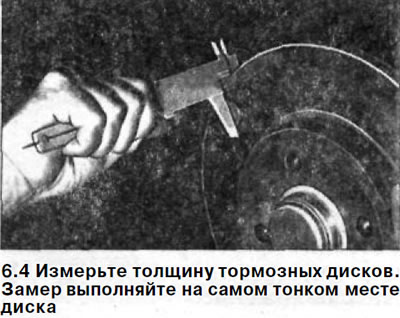2. Loosen the wheel bolts. The vehicle must be on wheels during this operation.
3. Place the vehicle on jack stands and remove the wheels.
Attention! There is a risk of injury when the vehicle is jacked up or placed on jack stands. Familiarize yourself with the provisions of the chapter «car jacking».
4. Measure the thickness of the brake discs. Measure at the thinnest point of the disk. In workshops, a special gauge is used for this, for example, HAZET-4956-1 or a micrometer, since due to wear of the disc, a deflection of its surface is formed.
Attention! The thickness of the brake disc can also be measured with a conventional caliper, but at the same time, a gasket of the appropriate thickness must be placed on both sides of the disc, for example, two coins (see illustration). To accurately determine the thickness of the brake disc, you need to subtract the thickness of the inserted coins or gaskets from the obtained value.

Attention! Measure the thickness of the brake disc at several points.
The dimensions of the brake discs are given in «Specifications».
If significant cracks or grooves deeper than 0.5 mm are found, the brake disc must be replaced.
Attention! Ventilated brake discs with cracks no thicker than a hair and up to 25 mm long do not need to be replaced with new ones.
5. Install the wheels in accordance with the labels applied during removal. Before doing this, lubricate the centering seat of the wheel disc on the hub with a thin layer of bearing grease. Do not grease wheel bolts. Replace rusted bolts with new ones.
6. Screw in bolts of fastening of wheels and lower the car.
7. Tighten the wheel bolts in a cross pattern to 110 Nm.
